Mindful parenting has me craving calmer mornings and kinder responses. Why I made this post is simple and honest. I want to give you easy tools you can use today. You won’t find a long to-do list that sits on a shelf.
If you’re a parent, caregiver, or teacher juggling routines, this one’s for you. Who it’s for are people who want less chaos and more connection at home, during meals, and at bedtime. You care about your kids, but you also want to take care of yourself and your relationship with them. You’ll find ideas that fit a busy schedule and a tight budget, with a big desire to stay calm.
1. Daily Gratitude Journals
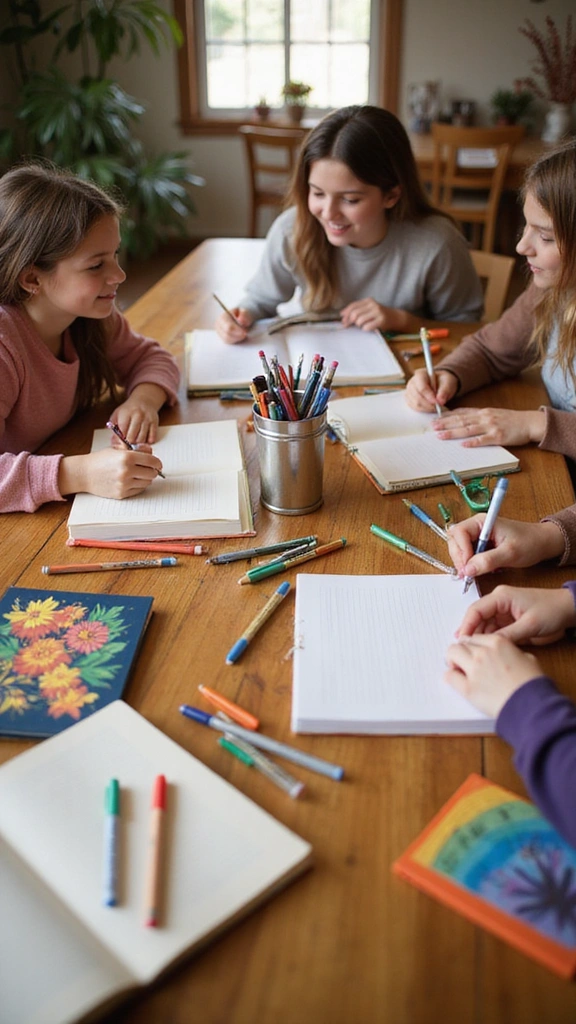
Daily Gratitude Journals
If you want calmer evenings and kinder kids, this simple habit helps. A daily gratitude journal lets your family pause, notice good moments, and grow together.
How to start today:
– Practice together: each night, everyone shares three things they are grateful for. This tiny ritual helps kids recognize feelings and care about others.
– Get creative: decorate the notebook with colors, stickers, and drawings. A kid’s page becomes a fun keepsake you’ll want to look at again.
– Make it a ritual: choose a fixed time, like after dinner or before bed, and keep the journal in a cozy spot. Consistency builds momentum.
Practical tips:
– Use quick prompts: “What made you smile today?” or “Who helped you today?”
– Let everyone participate: younger kids can dictate ideas, older ones can write.
– Display progress: a small gratitude wall or a shelf of finished journals boosts motivation.
Benefits you’ll notice:
– More appreciation for everyday moments and less stress in the evening.
– Kids grow in emotional awareness as they name feelings honestly.
– Family closeness strengthens when you share openly, even on rough days.
Common questions:
– How long does this take? About 5 to 15 minutes, depending on the night.
– What if a child stalls? Let them draw, narrate, or you jot notes while they speak.
Realistic notes:
– It isn’t a cure for all problems, but it is a steady step toward a kinder home.
– Consistency matters more than perfection, so keep it simple and doable.
Want more momentum? Add a quick “thank-you” moment at meals or a weekly note exchange to keep the habit going.
Product Recommendations:
• The 3 Minute Gratitude Journal for Kids
• 12 Sets 600 Sheets Washi Stickers for Journaling
• A Mindful Kids Journal: 50 Fun Activities to Help Kids Develop Emotional Intelligence
2. Active Listening Skills

You want your child to feel heard. But busy days pull you away from real talk. Active listening makes conversations calmer and closer.
– Eye contact keeps you connected, so your child feels seen.
– Reflect feelings verbally to show you care.
– Avoid interrupting so they finish and feel respected.
– Label emotions to help them name their feelings.
– Ask clarifying questions to show you want to understand.
– Summarize what you heard to confirm you understood.
– Give space after they finish before you answer.
– Use a calm tone to keep the talk steady and safe.
Listening is a skill you can grow. Your child learns to slow down, name feelings, and share more honestly.
Practice helps, but it won’t fix every moment. Keep the plan small and steady.
Try this one-week plan.
1) Set a phone-free time at meals and before bed.
2) Have a 10-minute daily chat with your child.
3) Start with your child sharing something from their day.
If you slip, gently start again tomorrow. Small steps, big gains over time.
Active listening builds trust and reduces fights. It teaches your child to handle big feelings and speak up when something matters. The goal is not to win an argument but to keep the conversation open.
Product Recommendations:
• The Mindfulness Journal for Kids
• MEROCO Feelings Emotions Cards for Kids Therapy
• 200 Family Conversation Cards
3. Mindful Meal Times

If meals feel rushed or tense, you can change that with a calm, shared ritual.
Turn off screens and set the table with care so everyone can breathe and listen.
Give each person a moment to share something from their day.
Ask everyone to notice flavors, textures, and aromas as they eat.
Mindful Dinner Recipe: One-Pot Tomato Basil Pasta
– 8 oz pasta (spaghetti or linguine)
– 2 cups cherry tomatoes, halved
– 2 cloves garlic, minced
– 2 tablespoons olive oil
– 2 cups water or vegetable broth
– 1/4 cup grated parmesan
– Salt and pepper, to taste
– Fresh basil leaves, torn
Steps:
1. In a large pot, heat olive oil. Add garlic; sauté 30 seconds.
2. Add tomatoes; cook until they soften and release juice, about 3 minutes.
3. Add pasta, water, salt. Bring to a boil, then reduce heat and simmer, stirring often, until pasta is tender and the sauce thickens, about 10-12 minutes.
4. Stir in parmesan, pepper, and basil. Serve warm.
With this recipe, you practice mindful eating and center the family around one simple dish.
Use the meal as a chance to slow down, connect, and model calm eating for your kids.
– Set a 20-minute goal for dinner and keep devices away.
– Have one person share a highlight and another describe a flavor they loved.
– Do a quick senses check: what do you see, smell, taste, and feel in your mouth?
– End with a small thank-you for the food or the person across from you.
Mindful meals take practice, but they slowly build stronger family bonds and healthier eating habits.
Product Recommendations:
• 100 Mindfulness Conversation Starter Cards for Kids
• Spode Kit Kemp 11″ Tall Trees Dinner Plate
• Mindful Eating
4. Nature Walks and Observations

If you want a simple way to calm kids while boosting curiosity, try a nature walk. You step outside, slow your pace, and let questions surface. A small notebook keeps the ideas honest and easy to track. Even 15 minutes can lift mood and make family time more meaningful.
– Explore the senses: Encourage your child to notice sounds, colors, and textures. Ask them to name one sound, one color, and one feeling they notice.
– Engage with questions: Talk about why certain plants grow in this spot or how animals adapt to the light or weather. Let them offer ideas first, then share your own.
– Collect inspiration: Bring along leaves, stones, or shells to discuss later. Use these treasures as prompts for quick science chats at home.
These moments help kids feel connected to nature and to you. They also boost emotional well‑being by turning quiet observation into shared conversation.
How to get started:
1) Plan a short, safe route (10–20 minutes works best).
2) Pack a small bag for treasures and a notebook or sketch pad.
3) End with a 2‑minute reflection: what did you notice, what surprised you, what will you explore next time?
4) Keep it flexible. If interest fades, switch to a game or a quick photo scavenger hunt.
This approach fits mindful parenting and fits busy days. You gain calmer kids, richer questions, and more confidence outdoors.
Product Recommendations:
• Nature Journal: A Kid’s Nature Journal
• 2 Pack 75mm 10X Handheld Magnifying Glass
• My Awesome Field Guide to Rocks and Minerals: Track and Identify Your Treasures
5. Emotion Check-In Points

If you want a calmer home and kids who speak up, start regular emotion check-ins. These moments give a safe space to hear how everyone feels and learn to handle hard moments together. They teach kids to name their feelings and find small, realistic ways to cope when stress rises.
– Set a time by choosing a short, predictable moment like a car ride home or after dinner to pause, ask an open question, and talk about the feelings you notice.
– Use emotion charts with simple faces on the fridge or a whiteboard to help younger kids label what they feel, from excited to angry, bored to scared.
– Encourage expression by validating each other’s feelings and sharing a few quick coping ideas, such as taking three slow breaths, counting to five, or stepping outside for a minute.
Regular check-ins create a family rhythm where feelings are named rather than buried, and you build trust that lasts through everyday stress. And with practice, you’ll notice fewer power battles, clearer conversations, and a sense that everyone is heard, even when the day gets tough.
Start tonight with a 5-minute check-in after dinner, and notice how a few calm minutes change the mood. You don’t need perfect words; just show you listen.
Product Recommendations:
• 12 Calming Corner Classroom Posters
• Sunny Days Entertainment Expandable Ball
• 200 Family Conversation Cards
6. Screen-Free Sundays
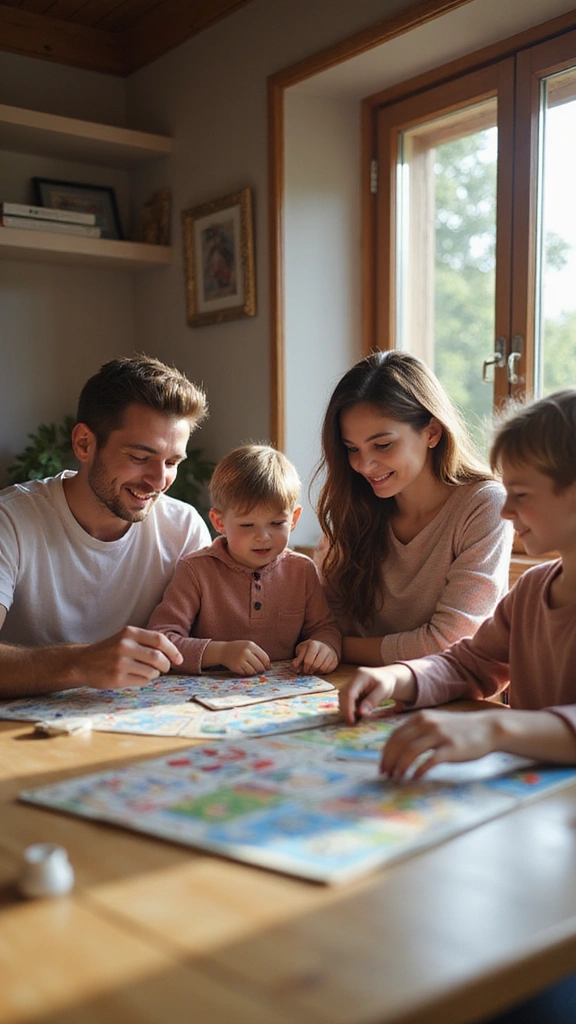
Screen time can pull you away from moments that matter. A weekly screen-free Sunday gives your family a steady, calmer rhythm you can count on.
– Choose a day. Pick Sunday or another day that fits your routine. Keep it the same each week so everyone can plan.
– Plan fun activities. Gather games, outdoor time, and simple projects. A varied mix keeps everyone engaged and smiling.
– Encourage creativity. Use this time for reading aloud, crafts, or storytelling. Let fresh ideas bloom without screens.
– Set goals together. Make a short list of activities you want to try. Check items off as you complete them.
– Create gentle rules. No phones or tablets in common spaces. If needed, keep a single device for emergencies only.
– Make it easy to start. Begin with a few hours, then grow to a full day as you all get used to it.
– Be flexible. If a plan flops, switch to a backup activity. Keep the mood light and encouraging.
– Notice the benefits. You’ll talk more, laugh more, and listen better. Quiet time helps everyone slow down and notice small joys.
Try it this week and feel your family vibe shift for the better.
Product Recommendations:
• Arts & Crafts Supplies Kits & Materials Set for Kids
• Rustic Ring Toss Game
7. Storytelling Time

Transform bedtime into a storytelling ritual. Telling stories fosters imagination and emotional connection.
– Mix it up: Alternate between reading books and telling personal experiences or family history.
– Encourage participation: Let kids become storytellers by adding their own twists or characters.
– Use props: Incorporate toys or puppets to make the stories come alive.
This routine not only enhances language skills but also creates a loving bonding experience that promotes emotional growth.
Product Recommendations:
• Melissa & Doug Safari Buddies Hand Puppets
• Set of 6
• The Storybook of Inspiring Tales
• Asmodee Rory’s Story Cubes Classic
8. DIY Stress Balls
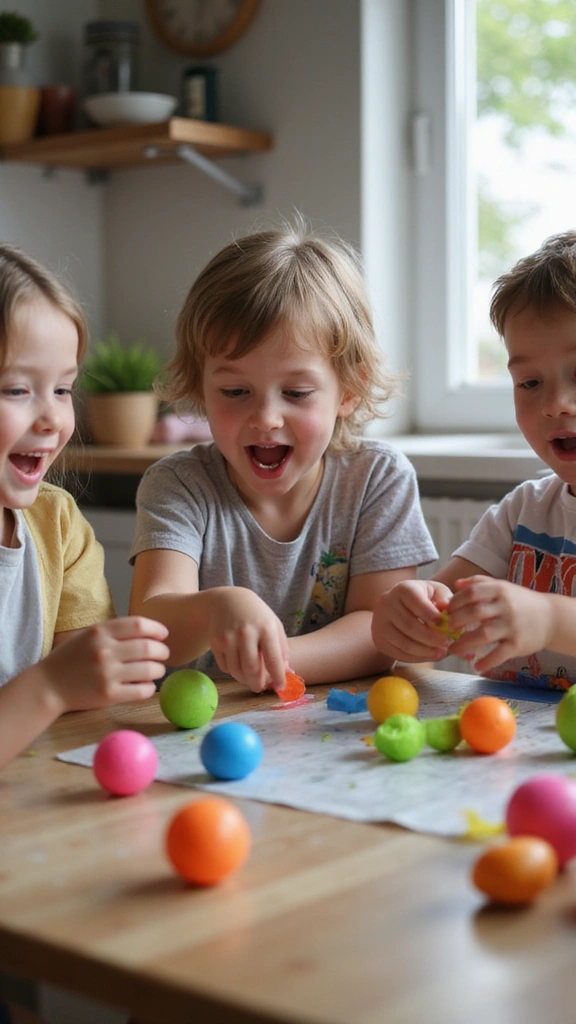
When your child feels stressed, you can use a simple tool to help them reset. DIY stress balls give kids something they can touch, squeeze, and control, even when feelings run high. They’re affordable, easy to make, and teach self-soothing skills.
Materials
– Balloons, flour or rice, and a small funnel
– Optional: dried beans or sand for different textures
strong>Steps
– Fill balloons: Place the funnel in the balloon neck and pour in the filler until the balloon feels firm but not full. Leave a little room to tie.
– Seal the balloon: Tie it securely so the contents don’t spill.
– Check the feel: Gently press the ball to feel how it squishes under pressure.
Mindful use
– When your child feels anxious, guide them to take a deep breath first.
– Then have them squeeze slowly for five counts, and release.
– Repeat a few times as needed. Pair the action with quiet breathing for best results.
Benefits
– This craft builds emotional regulation. Your child learns to notice tension and choose a calming action.
– It’s portable, affordable, and easy to customize with colors or scents.
Safety tips
– Supervise younger kids to avoid choking hazards.
– Use larger balloons or place the filled balloon inside a sock for safer handling.
– Wash hands after use and store in a dry, reachable spot.
Product Recommendations:
• 12 PCS Milky Blank Skins Empty Stress Ball DIY Kit
• Magic Flour Stress Balls for Kids – 6 Pack Fidget Toys
• Mini Funnel Small 10-Pack for Lab Bottles
9. Family Dance Parties

Family dance parties: a quick fix for stress and a boost to bonding
You want an easy way to lift everyone’s mood and calm tense moments.
A family dance party fits. It blends play with movement and makes laughter happen.
You feel the room light up as the beat fills the air.
A quick burst of music can reset energy.
This helps mindful parenting by bringing you into the moment together.
– Pick a playlist that includes everyone’s favorite songs.
– Set a time that fits your family, either weekly or on demand.
– Encourage creativity by making up goofy moves together.
This simple routine can melt stress, boost energy, and create warm memories.
It’s not a cure-all, but it gives your family a shared, joyful moment.
Try this tonight and notice the small shifts in mood and teamwork.
Keep it simple: start with two songs and a 5–10 minute timer.
Clear the space and choose a safe, comfy area where you can move freely.
Let kids take turns leading to build confidence and participation.
Try different themes like a dance from a decade or a quick burst of freestyle.
End with a quick high-five or hug to seal the moment.
Product Recommendations:
• Anker Soundcore 2 Portable Bluetooth Speaker
• Kids Music Playlist
• Vol.7
• Flooyes Dance Mat Toys for 3-12 Year Old Kids
10. Emotion-Related Books
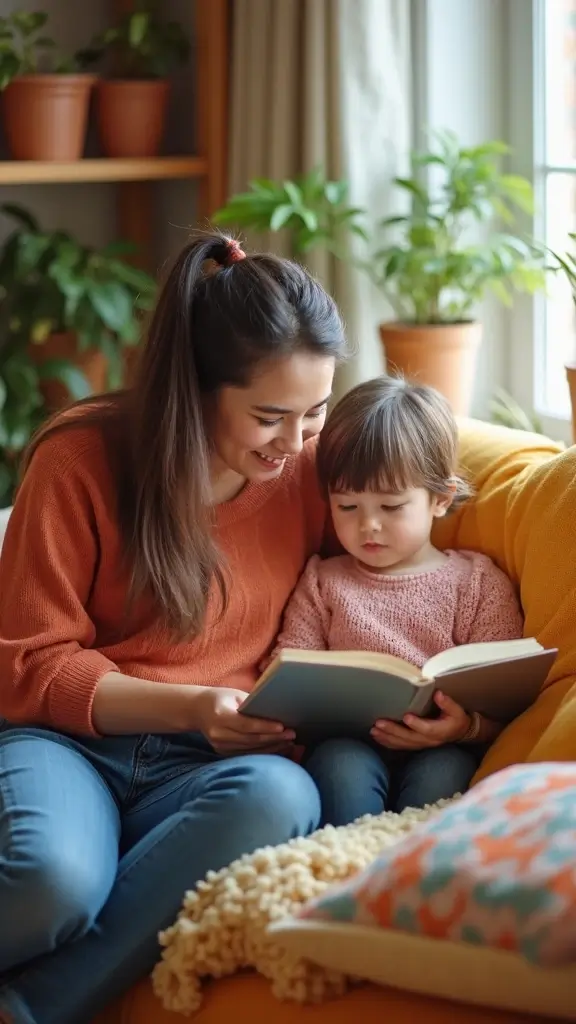
You want your child to talk more about feelings. Emotion books for kids can open that door. They boost literacy and help kids recognize feelings in everyday life.
Try these steps to use emotion-related books effectively.
– Choose relatable titles – Pick stories that fit your child’s days. Worry before a test, anger after a game, or joy after a small win.
– Discuss after reading – Ask open questions about the character’s feelings and choices. Let your child share their own take in their words.
– Make connections to real life – Link themes to what happens at home or school. Ask for a recent moment when they felt a similar emotion.
– Practice with activities – Draw a face showing the feeling. Act out a quick scene from the book.
– Keep it brief and steady – Keep sessions short so it stays fun. Try a few minutes, two or three times a week.
With time, your child will name more feelings and respond with care. Reading together builds trust and calm at home. Try it this week and notice small shifts in how you talk about feelings.
Product Recommendations:
• The Color Monster: A Story About Emotions (The Color Monster
• 1)
• In My Heart: Deluxe Gift Edition: A Book of Feelings
• The Feelings Book
11. Mindful Playdates

You want playdates that help kids grow emotionally, not just fill the afternoon. Mindful playdates center on connection, cooperation, and kindness. They turn ordinary time into chances to learn and make friends.
– Choose activities that require teamwork Pick games and crafts where kids must talk, plan, and work together. For example, build a big fort from blankets or create a shared art mural.
– Encourage sharing and empathy When sharing happens, pause to name the feeling. Ask simple questions like “How did that feel?” to help kids understand others.
– Set gentle structure Plan a 60–90 minute session. Give each child a small role so everyone contributes.
– Observe and guide Watch how they interact. If trouble grows, name the emotion and guide them to a calm, respectful talk.
– End with reflection Finish with a quick chat about what worked and what could be better next time.
A mindful playdate builds emotional intelligence. With practice, your kids learn to listen, share, and solve problems together, creating friendships that last.
You will see calmer mornings, easier school days, and happier smiles after play. Add a short snack break, rotate hosting, and use a simple rule like ‘hands to ourselves’ to keep kids calm together.
Product Recommendations:
• Castle Panic 2nd Edition
• Arts & Crafts Supplies Kits & Materials Set for Kids
• MEROCO Feelings Emotions Cards for Kids Therapy
12. Inspirational Quotes Jar
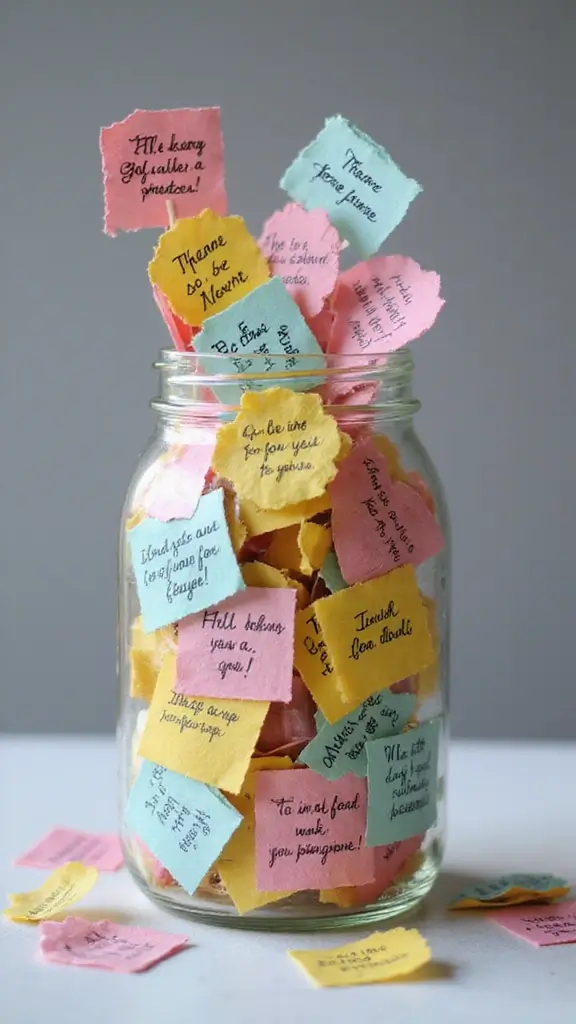
You want a simple way to lift your family. An inspirational quotes jar helps you do it with ease. It brings daily inspiration and builds positive habits for everyone.
Set it up in minutes
– Choose a jar or container that sits easily on the kitchen counter. Clear glass helps you see the slips and their messages.
– Cut small slips of paper and grab a pen.
– Invite each family member to add one quote or affirmation. Short lines work best for quick reads.
– Label a spot in the jar with today’s date. This helps rotate ideas later.
– Mix the slips so every draw feels fresh and hopeful.
How to use it every day
– Draw a quote once a day, at a time that fits your routine.
– Read it aloud and talk about what it means for your day. Keep explanations short.
– Encourage kids to share a brief thought in their own words.
– You’ll hear fresh perspectives that teach you something new.
– Keep the jar in a visible spot. A small ritual around coffee or after dinner helps it stick.
Themes that keep it alive
– Change topics monthly: kindness, perseverance, gratitude, or teamwork.
– Display a few quotes on the fridge as reminders.
– Use the practice as a family check-in, not a rule. It should feel warm and hopeful.
Bottom line: a quotes jar builds resilience and family unity through simple nudges.
Product Recommendations:
• Anchor Hocking Heritage Hill 1 Gallon Glass Jar with Lid
• Better Office Products Motivation Inspiration Affirmation Cards
• Watercolor Styles Aesthetic Stationery Paper
13. Family Vision Board Updates
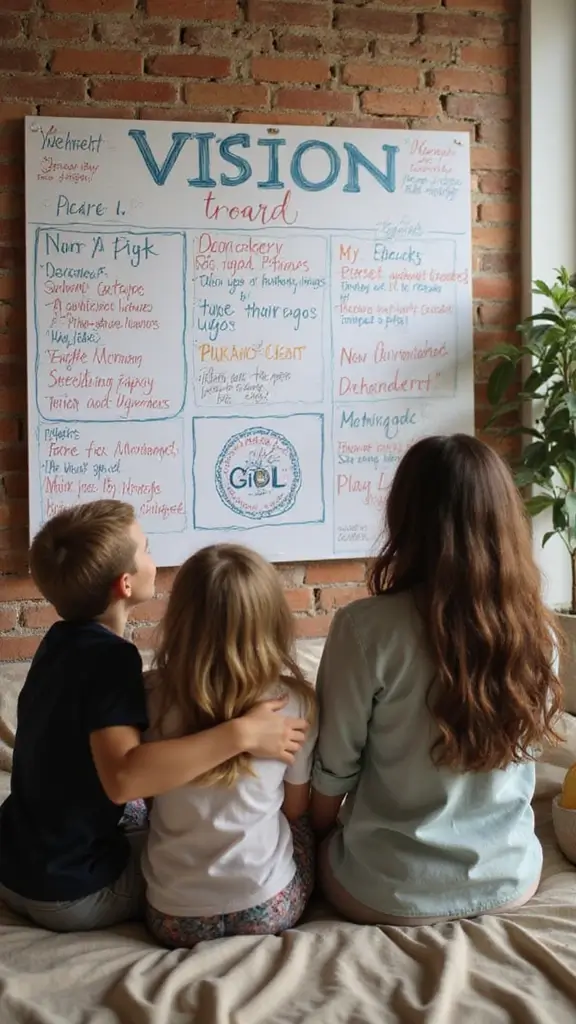
Keep your family vision board fresh to reflect your changing dreams. Life shifts, and your goals should shift with it. A living vision board helps you see what matters and stay close as a team.
– Schedule updates: Pick a fixed date each month or season and sit down together.
– Reflect on achievements: Review what you’ve finished, celebrate wins, and name a new goal.
– Re-involve everyone: Invite each member to add a fresh thought or picture, so it stays lively.
This ongoing practice builds shared purpose and a sense of unity as you walk through daily life.
How to put it into action:
– Gather a board or wall space, markers, scissors, photos, and magnets.
– Choose 3-5 big family goals and 2 small monthly actions, written in simple terms.
– Move and refresh notes as you complete steps; snap a quick photo to track progress.
– Set a reminder day for updates and make it a positive, quick ritual.
Common questions:
– What if goals change? You can shift them. Keep the board simple and meaningful.
– How often should we update it? Monthly updates work well for most families.
Reality check: it won’t fix every problem, but it does help you focus on what builds your family.
Latest ideas: use a digital board, color codes for zones (health, learning, fun), and add photos from recent adventures.
Product Recommendations:
• Cork Board Set for Wall
• 80 Colors Alcohol Markers
• YixangDD 15 Pack Magnetic Picture Frame
Frequently Asked Questions
What Are Mindful Parenting Hacks and How Can They Benefit My Family?
Mindful parenting hacks are simple, practical strategies designed to help families connect and communicate better. By incorporating techniques like active listening and mindful meal times, you can foster an environment where everyone feels valued and understood. These hacks not only promote emotional intelligence among children but also create a calmer, more harmonious home life.
How Can I Introduce Daily Gratitude Journals to My Family?
Introducing daily gratitude journals is easier than you might think! Start by providing each family member with a notebook or even a shared family journal. Set aside a few minutes each day, perhaps at dinner, to reflect on what you’re thankful for. This practice encourages positive thinking and helps cultivate a sense of appreciation within the family, making evenings more peaceful and fulfilling.
What Are Some Effective Conflict Resolution Techniques for Kids?
Teaching kids conflict resolution skills is crucial for their emotional development. One effective technique is role-playing, where kids can act out different scenarios to practice resolving disagreements. This not only helps them learn to approach conflicts calmly but also fosters empathy by allowing them to see things from another person’s perspective.
How Can I Encourage Mindfulness in My Children?
Encouraging mindfulness in children can be as simple as incorporating fun activities! Try mindful breathing techniques or create a quiet corner for them to unwind. Nature walks can also be a great way to help them observe their surroundings and practice being present. These activities teach kids to recognize their feelings and thoughts, ultimately equipping them with valuable coping skills.
What Are Screen-Free Sundays and How Can They Improve Family Dynamics?
Screen-free Sundays involve disconnecting from devices for a day to promote real-life connections. This practice can significantly enhance family dynamics by encouraging quality time and open communication. Use this time for activities like board games, outdoor adventures, or simply sharing stories, which helps strengthen bonds and allows everyone to engage more deeply with one another.
